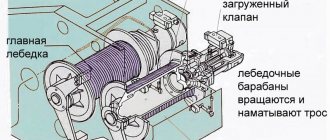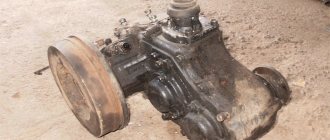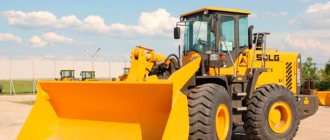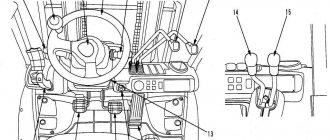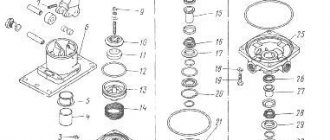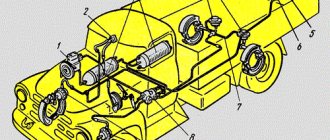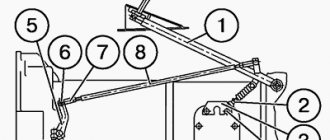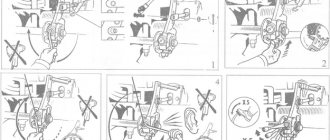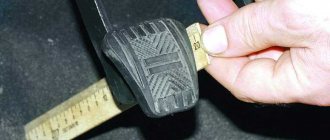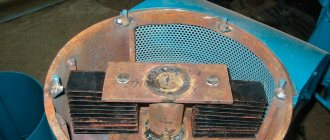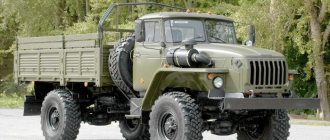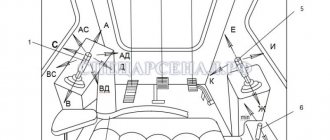Loaders, like excavators and dump trucks, are among the most popular among special equipment. The machines can be used on a construction site, in a production workshop, warehouse, or logistics center. Today, having a permit to drive a forklift, you can find a sought-after, high-paying job. Modern models are equipped with convenient levers and pedals, which greatly simplifies the control of front-end loaders and forklifts, both with manual (manual) and automatic (automatic) transmissions.
Types of forklift control levers
The mechanisms responsible for the movement, control and stopping of equipment are conventionally divided into the following groups:
Travel levers
A loader with a manual transmission and an automatic transmission with mechanical gear selection is equipped with two shift knobs - one for selecting the direction of travel, the second for selecting a gear. Using these controls, you can move forward/backward and change speed - two to four gears for moving forward and one to two for moving backward.
If you set the driving direction switch lever to the “R” position, the equipment will begin to move backwards, a special signal will sound, the headlights will light up, or the reverse signal will turn on.
To start moving and change the direction of movement of a self-propelled material handling machine, the brake pedal must be pressed before switching the lever. To switch the direction back and forth and vice versa, the machine must be completely stopped.
Gear shift lever
Before starting to operate the gear shift lever (for a fully automatic transmission), the brake pedal is depressed. After the pressure on the brake pedal is released, the car begins to move slowly. In this case, the speed shift knob is in any position except neutral. The brake pedal is fully released only after you are completely ready to move.
The equipment is equipped with one shift lever located on the steering column. There are two to four gears for forward movement and one to two for reverse movement. In the “R” position, the reverse lights come on or the horn sounds. Switching the direction of movement of the vehicle from front to rear and vice versa is carried out only after the vehicle has completely stopped.
Manual control of the loader
Manual control of a loader with an automatic transmission with a mechanical gear selection involves working with a direction shift lever corresponding to the steering wheel drive switch (for a fully automatic transmission). Before starting the equipment, the lever must be set to the neutral position. Otherwise, the special equipment will not start.
Steering column tilt lever
Before starting the loader engine, the operator must sit in the driver's seat and adjust the steering column lever to position "A". This will allow the steering column to be secured. It is not safe to make adjustments while the equipment is moving. You should choose the most convenient angle of the steering column so that the driver can work comfortably. To do this, the lever is moved to position “B”, the optimal angle of inclination is selected, the handle returns to mode “A” and the selected position is fixed.
Parking brake
To park the forklift, the wheels must be blocked. To block the 2 rear (usually) wheels, the lever is pulled towards itself. To release the parking brake, the release button at the top of the lever is pressed and held, and then the lever is moved forward.
Carriage lift lever
Before operating the forklift, it is important to ensure that no one is nearby. To raise the forks, pull the carriage lift lever towards you. To lower the forks, the handle must be moved to the forward position. The lifting speed of the attachment is adjusted by changing the tilt of the lever, engine speed, and pressing the accelerator pedal. You can speed up or slow down the lowering of the forks only by changing the angle of the lever. The number of revolutions of the loader engine does not affect the speed of lowering the forks.
Tilt lever
Before working with equipment, it is important to make sure that there are no people nearby. To tilt the mast back, the tilt lever is moved back. To change the direction of the mast and move it forward, the handle is set to the forward position. You can change the speed of movement of the mast using the tilt lever and the gas pedal.
When the engine is not running, it will not be possible to tilt the mast forward, because the tilt lock on the control valve is activated. If you press the lift lever while the forklift engine is not running, the forks will lower forward.
Inching pedal
The inching pedal for an automatic transmission is designed for use during high-speed operation. Lightly pressing the pedal reduces the hydraulic clutch pressure. When the pedal is pressed all the way, the clutch is completely disengaged and the braking system is activated. It is not allowed to turn on “slow travel” to slow down the equipment when going down or going up a slope, because the clutch will be disconnected, which will make engine braking impossible. Refer to your forklift owner's manual for more information on how to operate the crawl pedal.
Brake
To slow down the movement of special equipment, press the brake pedal. When pressed, the brake lights come on.
Accelerator
You can speed up the movement of the forklift by pressing the gas pedal. When you release pressure on the accelerator pedal, the forklift engine starts to idle. On gasoline models, a manual or automatic choke is used to start the loader in cold weather.
Interesting information
Of course, in order to master operating a forklift using a joystick, you need to undergo training. Once you understand the nuances of the process, there will be no problems or difficulties. For example, in order to lift using a joystick, you just need to move its handle forward; to lower it, you pull it towards you. To perform loading, for example, scooping up bulk materials with an excavator bucket, the joystick is directed to the right. To free yourself from the load, go left. Even the fact that the price of components for such a loader control system is more expensive than a lever control system is compensated by high performance.
As for the levers, their main advantage is that they are made using technology that has been tested over the years. They rarely break and are easily repaired. The components are cheap. However, more and more forklift owners prefer joysticks. And the advantages listed in the previous block play an important role in this.
Joystick control technique
The joystick is located in the loader cab to the right of the driver.
Forklifts are controlled using a joystick as follows:
- for lifting - point the handle towards you;
- to lower - push the joystick away from you;
- loading movement of the bucket (raking) - handle to the left;
- releasing the bucket from the load - moving the handle to the right.
The joystick control system is extremely easy to learn. In some modern models, the control unit includes a mobile joystick. This is convenient for the operator who will perform the work with his left hand - the handle is installed on the left side. This greatly simplifies the operation of mini-loaders, and operators save effort - just put your hand on the joystick, while keeping your shoulders and arms practically relaxed.
To ensure safe operation of the equipment, before starting the engine, you need to make sure that the machine is in good working order, check its technical readiness for work - the level of coolants, oil, brake fluid, fuel level, charging the electric forklift battery. Be sure to check the operation of the brake and clutch pedals, parking brake, gear shift lever, serviceability of the turn-on elements, sound and light signals.
Note to managers of warehouses, construction and agricultural organizations
It is quite easy to maintain such loading machines. This does not require large investments or time. All spare parts for front loaders are available. To maintain equipment, you just need to find a reliable supplier, and this is real! One of the best companies working in this direction is Belagro. The organization operates in the format of an online store and delivers certified components from the manufacturer throughout Russia.
Attachments
In most cases, the main attachment of a loader is a bucket. It is used for loading bulk cargo, moving, and storing. However, if necessary, special equipment can be supplemented with a fork part. The forks allow you to conveniently work with tared and palletized loads. Most forks are designed to move loads in an up/down direction. However, there are also models with a telescopic boom that can extend several meters forward. But even in such multifunctional options, ease of control of the loader is ensured. To operate equipment, you must have a state-issued “forklift operator” certificate with the required categories.
Main characteristics
Loaders, although they are physically controlled like any car, still have their own characteristics. Before you start learning to ride this device, there are several factors to consider:
- The weight of the mechanism is significantly greater than that of other passenger cars, and its dimensions may be smaller, which must be taken into account during the first times of use.
- The goods are transported from the front using forks, which can sometimes cause poor visibility. This factor is also particularly important.
Specifics of drawing up a job description
The current domestic legislation does not set out the parameters for drawing up a job description. As a result, employing companies can freely adapt the content of standard sample instructions to suit their needs. As for the form of the document, there are certain standards that are used when writing it. The usual instructions consist of the following sections:
- General section.
- Employee functions.
- His labor rights.
- Possible measures of liability.
To these standard sections, employers often add:
- Working conditions.
- Work connections.
- Parameters for assessing the quality of work.
- Qualification requirements.
Additional parts are especially in demand in large companies that seek to transfer as much of their activity as possible into a standardized documentary form, which greatly facilitates the interaction of hundreds of employees with many overlapping functions.
Attention! The instructions can be drawn up in a standard form suitable for any employee, or they can be individual in nature, being designed for a specific employee.
a common part
Here is a description of the main labor parameters. Key points include:
- who replaces the driver during his absence;
- to whom he is subordinate;
- on whom his hiring and dismissal depends;
- what provisions should the driver follow;
- what are the necessary qualification parameters of a candidate for the position, as well as the skills required of him.
If some of the points are quite typical, then those points where the requirements for skills and abilities are given strongly depend on the nature of the employer’s activities. In logistics services, construction companies or trading companies, the functions of a forklift driver may vary, as will the skills required for them.
Attention! A forklift driver may be required to have a separate type of license to operate categories of that vehicle. In addition, some companies hire forklift drivers of certain categories. All these features must be fixed in the qualification requirements.
Functions
It describes both the standard responsibilities of any driver and those that are specific to a forklift driver. The first type includes functions for ensuring transport of fuels and lubricants, monitoring the quality of repairs, maintaining order, and the like. The second type of responsibilities includes placing goods in the warehouse, monitoring their fastening and stowage, as well as other specific issues. It is necessary to separately mention the importance of compliance with traffic rules and relevant safety standards.
Attention! Many companies practice issuing work clothes, appropriate tools and equipment to drivers at their own expense. In this case, it is necessary to separately mention the employee’s obligation to carefully store and operate these things.
Responsibility
Here are descriptions of the main types of violations for which an employer can punish an employee. Punishments are given in the most general form, since the degree of guilt can only be revealed during appropriate proceedings, with the involvement of witnesses, evidence, etc.
Rights
This part is reserved for the list of employee rights. Typically, several standard items are listed here, common for all employees of the same rank. Technical employees, which include the driver, may have added rights to require the employer to carry out necessary repairs and refuse to drive if the vehicle is in critical condition.
The forklift driver is responsible not only for carrying out the relevant work, but also for the safety of his machine. Therefore, it is necessary to take a responsible approach to writing instructions, paying attention to the need to take into account the opinions of relevant specialists. Only after taking into account their edits can the document be submitted to the director of the company for signature. When drawing up instructions, it is also required to take into account the presence of all the parameters required in an official document: date, company details, decryption of signatures. The employee himself puts his signature in the hiring process. Other signatures may belong to persons with whom this appointment was agreed upon.
Movement on an inclined surface
Driving on slopes requires caution. If the rules are not followed, the forklift may become unstable and tip over. Let's look at how to operate a front loader correctly.
Rules for using a loader on a slope:
- Driving downhill in neutral is prohibited;
- the bucket should be located at a distance of 20-30 cm from the ground surface. In emergency situations, it can be used for braking;
- in case of slipping or loss of stability, in order to slow down the movement, you need to lower the bucket;
- The bucket will serve as a brake when parking on a slope. To prevent slipping, place supports under the wheels;
- Low temperature of the working fluid reduces the efficiency of the loader on a slope. It needs to be warmed up before starting work.
Loading work
The methods used to control a front loader when performing loading operations differ. The most effective work is considered to be when minimizing the angle of rotation of the loader with a minimum distance between it and the dump truck.
There are two methods. The first is to move the forklift in reverse. The dump truck is positioned between the loader and the material. This is a fast and efficient loading method. Requires a level construction site.
The second method involves the following sequence:
- Parking at a 60 degree angle to the loading machine. With the bucket filled, the loader moves towards the dump truck in reverse and unloads;
- the soil must be unloaded into the middle of the dump truck. If its length exceeds 2 widths of the bucket, loading begins from the front;
- soil is unloaded into the dump truck by moving the control lever to the right position;
- the remaining material stuck to the bucket is shaken off by moving the control lever to the right and left;
- Before unloading, the bucket must be shaken so that the material is evenly distributed in it. This will prevent sticking.
To avoid danger
- To avoid impacts and collisions, be careful in areas with uneven or slippery surfaces.
- Stay away from foreign objects in the path of the forklift, which could cause loss of control or the load falling.
- Use the horn when approaching corners, openings, driveways, etc. to warn pedestrians and other forklift operators and avoid collisions.
- Maintain your distance when driving near other forklifts.
- Provide sufficient braking distance.
Learning to ride
- First of all, before you get behind the wheel, you need to know how to start and how to control the vehicle. Basically, the principle of its operation is very similar to driving a regular car, and if you already have such skills, this will help you a lot.
- First, try driving the forklift just like that, without a load or other equipment. You have to get used to controlling it and feeling it.
- When you have mastered the basics of control, you can begin to study the basic functions of your device. Forklifts have special levers near the steering wheel that allow you to move the fork in several planes. To do this, practice working with them. If you have a wooden pallet, then you can carry it around, learn how to pick it up or put it down.
- When you already feel confident, you can try moving oversized cargo. However, you should never rush, as this can be dangerous both for your health and the health of others.
Develop your driving skills gradually and never immediately take on an impossible job that you have not done before. Although sometimes from the outside it even seems like a very simple task.
It is also important to follow safety precautions and be careful not to cause harm.
Theoretically, you can learn to drive a forklift thanks to this video:
